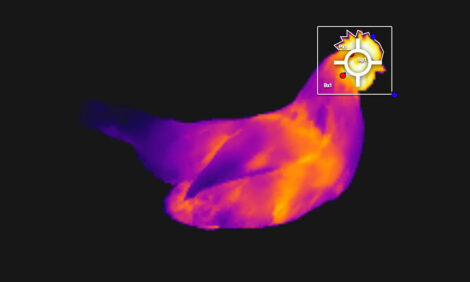



Atlanta Forum Centres on Feeding
Feeding and nutrition formed a key focus for the new research presented at the International Poultry Scientific Forum in Atlanta, Georgia, US, in January 2015. In this report, we look at the potential of novel feed ingredients – some new to poultry feeding and some new forms of familiar feedstuffs.Low-tannin Grain Sorghum for Broilers
Use of grain sorghum (also called milo) has been hampered by its lower chicken skin-pigmenting ability than corn (maize) and the low nutrient value of so-called high-tannin “bird-resistant” varieties, said Professor Park Waldroup of the University of Arkansas.
More recently, he said, the growth in further processing has reduced pigmenting demands, and sorghum growers in the US no longer produce the high-tannin varieties.
In an Arkansas study, a supply of locally-grown grain sorghum was analysed and used in starter, grower and finisher feeds in which it replaced 0, 20, 40, 60, 80 and 100 per cent of the grain component of the diet for male broilers for 42 days.
There were no significant differences between the groups in terms of bodyweight, feed conversion, mortality, dressing percentage or breast meat yield.
Although shank and skin pigment scores were linearly reduced with each increment of grain sorghum, Professor Waldroup concluded that the new low-tannin grain sorghum is a suitable replacement for part or all of the grain in a broiler diet when skin pigmentation is not a determining factor.
Black Soldier Fly Meal Evaluated as a Broiler Feed Ingredient
There has been more interest in alternative protein sources for poultry and other food-producing animals as the growing demand for food sets up competition between people and animals for quality nutrition.
Shurong Li of Pennsylvania State University said that black soldier fly (Hermetiu illucens) prepupae can be considered as an alternative insect-based protein source for poultry nutrition because of its high protein (44 per cent on a dry matter basis and methionine and lysine contents (0.89 per cent and 2.79 per cent, respectively) , which make it comparable to meat and bone meal.
She and her colleagues inoculated fly eggs into nutrient trays of hen manure collected from manure belts. After approximately 12 days, the larva gradually turned to the black prepupae then crawled up a ramp to a self-collection tray. The prepupae were washed, dried, ground to pass through a 1-mm screen and then mixed to obtain a homogeneous meal (FPM).
In their study, the meal contained 42.2 per cent crude protein, 4.08 per cent moisture, 26.6 per cent crude fat, 0.59 per cent phosphorus and 6.09 per cent calcium (as-is basis).
Four dietary treatments with zero, 2, 4 and 6 per cent FPM were formulated to meet Cobb 500 recommendations and fed as organic diets to evaluate their protein and amino acid contribution for broiler chicken growth performance.
For the entire experimental period, different inclusion levels of FPM had no significant effects on body weight, mortality or processing yields, although feed intake was reduced for the highest level of FPM compared to the standard corn-soybean control and other treatments. Feed to gain ratio followed a similar significant trend.
FPM was a beneficial nutrient supplement in broiler diets at a moderate inclusion rate and was only limited by its high ash and calcium content, concluded Ms Li.
She added that, because of its favourable fat, energy, protein and amino acid profile, black soldier fly prepupae meal appears to offer potential as a dietary ingredient for organic poultry production.
Pennycress Meal as a Feed Ingredient for Broilers
Pennycress (Thlaspi arvense) is an annual winter plant found in North America that is being evaluated as a potential source of biodiesel, according to Rashed Alhotan, a graduate student at the University of Georgia.
In his presentation, he explained that pennycress meal (PM) is the by-product of pennycress seeds after oil extraction and he reported that the Athens-based researchers have evaluated the effect of its inclusion and feed form on the live performance of broilers up to 18 days of age.
The diets contained four levels of pennycress meal (zero, 5, 10 and 15 per cent of the diet) and provided in two forms (mash or crumbles), resulting in eight dietary treatments.
Increasing the inclusion level of PM from zero to 15 per cent resulted in a linear decrease in feed intake during the first 10-day period and throughout the experimental period.
Increasing the inclusion level of PM resulted in a linear decrease in bodyweight gain for the period zero to 10 days after which, the decrease accelerated further.
Increasing PM levels depressed feed conversion ratio linearly during the first 10-day period but it had no impact over the whole study period.
No differences were found in mortality rates due to PM feeding.
Feed form had no effect on feed intake but chicks fed the crumbled diets had a higher bodyweight gain than the mash-fed birds over the first 10 days and the 18-day period.
Feed conversion ratio was improved when feeding crumbled diets compared to mash diets over both periods.
Mr Alhotan concluded from these results that feeding broiler starter duet with up to 10 per cent PM produced similar performance to the zero-PM diet but 15 per cent PM depressed growth.
Consistent with previous findings, the performance of chicks fed the crumbled diets was superior to those fed mash diets.
New Soybean Variety for Turkeys
Soybeans and corn are the major ingredients in poultry diets. However, as C.E. Evans of North Carolina State University explained, unlike corn, soybeans must be extensively processed to reduce anti-nutritional factors such as heat sensitive trypsin inhibitors. Recently, however, a non-GM soybean variety has been selected for reduced levels of trypsin inhibitor, potentially allowing their inclusion in turkey diets without further processing.
The North Carolina study aimed to evaluate the novel soybeans as a feedstuff for turkeys as well as to determine the optimal inclusion level and feed form of the diets.
They used six dietary treatments, based on inclusion level of the novel soybeans (zero, 20 or 40 per cent) and feed form (mash or crumble).
The soybeans and grains were roller-milled to yield the mash diets of 700 microns, while the crumbles were pelleted at 180°F prior to crumbling.
The diets were fed to female LW poults to 21 days of age.
Birds fed the novel soybeans as a crumble were heavier than those fed the same diet in mash form and a similar weight to the controls receiving none of the novel soybeans.
Overall, inclusion of the novel soybeans – as mash or crumble – decreased bodyweights but the differences diminished as the birds became older, leading Ms Evans and her colleagues to conclude that that age improved the bird’s ability to process the higher inclusions of the novel soybeans.
Poults receiving the 20 and 40 per cent novel soybean diets as mash consistently had the lowest feed intakes, while the other diets were similar.
Feed conversion ratio followed the same trend, with the best feed conversion ratio achieved by the zero, 20 and 40 per cent novel soybean diets fed as crumbles. All the birds fed the diets as mash had the worst feed conversion ratios.
The researchers concluded that the novel, low-trypsin inhibitor soybean is a viable ingredient for use in turkey diets.
They added that its effectiveness was improved by feed pelleting and that further improvements may be possible by other actions such as the inclusion of enzymes.
Mechanically-pressed Soybean Meal for Broiler Chickens
Two trials have been conducted at Dalhousie University in Canada to determine the effect of heat and enzymes on the energy value (measured as nitrogen-corrected apparent metabolisable energy; AMEn) of mechanically-pressed soybean meal (MPS) and to evaluate the effect of graded levels of MPS on production performance of broilers.
According to presenter, Banuka Rajapakse, mechanical extraction of the oil from soybean results in more oil retained in the meal and a good protein content. However, anti-nutritive factors (ANF) such as trypsin inhibitors may also be present and reduce the feeding value. ANF can be inactivated by heat but this work looked at the possibility of using feed enzymes.
The first trial, conducted in cages, tested two oil levels (7 or 11 per cent oil), two heat treatments (heat or no heat) and four enzyme treatments (carbohydrase, protease, lipase or no enzyme) in a factorial arrangement.
In the first trial, carbohydrase improved the energy value of 11 per cent heated and non-heated MPS more than the zero-enzyme treatment (with or without heat).
In the 7 per cent heated meat, enzymes did not improve AMEn.
Lipase increased the energy value of the 7 per cent non-heated MPS compared to non-enzyme control.
For the second trial, AMEn values determined using excreta and diets were used to formulate starter, grower and finisher diets for a growth experiment in floor pens with diets containing 0.05 per cent Superzyme®(Canadian Biosystems Inc.).
There were four different treatments, involving two heated meal containing 9 or 13 per cent oil at four levels of inclusion (0, 5, 10 or 15 per cent).
The highest level of inclusion of the meal (15 per cent) reduced bodyweight gain during the starter and grower periods, regardless of oil level.
During the finisher phase, bodyweight was lower for the 10 per cent inclusion level than for the control with none.
Feed consumption during the starter period was not affected by inclusions. In the grower and finisher phases, feed intake was higher at 10 and 15 per cent inclusion levels than for the control diet.
Feed conversion ratio was not affected by dietary treatment in the starter, grower or finisher phases.
March 2015








